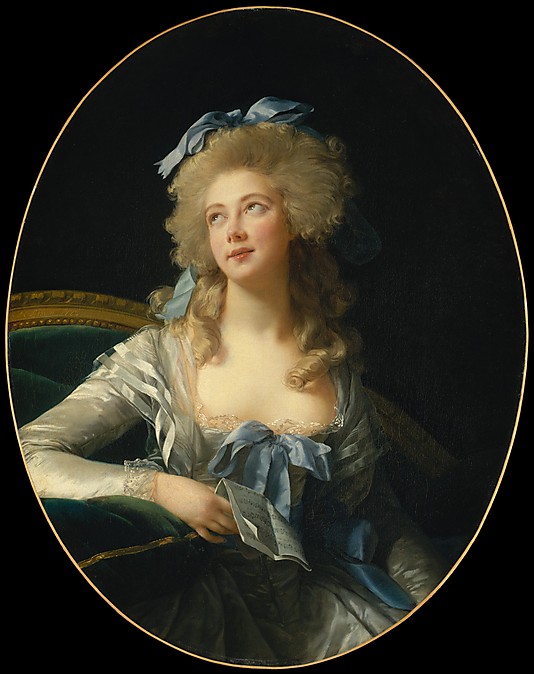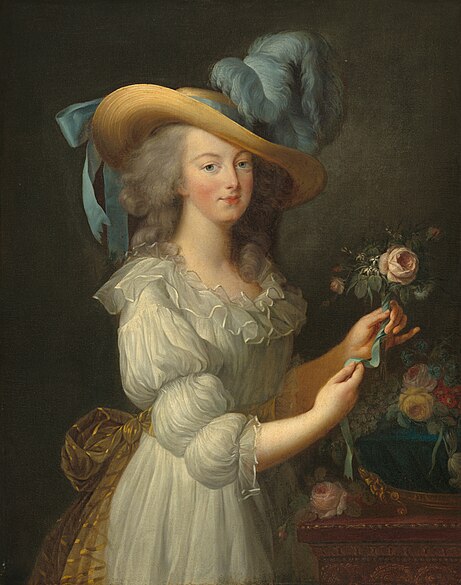Running through the 1780s - Part I
Okay, I really had no intention of continuing this schtick. I don't just want to concentrate on the eighteenth century! I also don't want to raise expectations of continuous, researched posts! However, I realized when I finished the 1770s posts that I've got a fuzzy impression of the 1780s, and I don't really think much of my ability to date extant gowns from the decade.
The Early 1780s (1780-1783)
The titular charmer wears a jacket and petticoat, trimmed with matching satin stripes. The jacket has long sleeves, and ties closed at the neckline in the polonaise style.
This woman is wearing a Levite, with a closed front, amadis sleeves, and a turn-down collar; the main form of trim on her gown is a white ruffle. She also has a long sash tied around her waist, and a slightly trailing skirt.
The mother is wearing an anglaise which closes center front, and has sleeves trimmed with ruched cuffs around the elbow and a short ruffle. Her skirts are tied up to reveal a petticoat trimmed with a small flounce above the hem.
The woman is wearing a closed-fronted rétroussée anglaise or polonaise (probably the former, as the folds in the skirt make it look like there's a waist seam) with a bow at the neckline. Her petticoat doesn't match her gown, which is printed with small sprigs on a light ground.
Du Barry is wearing a chemise gown - possibly the earliest in paint? It has a double ruffle of lace at the high neckline, and long, full sleeves. Blue ribbons decorate the neckline and the waist.
This gown is a sort of hybrid between a Levite and a polonaise, with a collar and a rounded, pulled-up skirt. The ruched cuffs are fitted around the elbow.
While the woman in the center of the picture has a fashionable dress with ruched cuffs, the older lady on the left has sleeves which probably end above the elbow, and have the older style of pleated cuffs. She is wealthy, though, and her dress (which might even make use of a stomacher) not being up-to-date does not detract from the impression of the scene.
The servant women washing Lord North are all wearing gowns and jackets with plain cuffs. The woman on the left has a miser's purse hanging from her waist. The fronts of their bodices are obscured by their kerchiefs, which are mostly not tucked in. All of the women have shoes with a slight heel, and all but one have ruffles showing from under their cuffs. They present a very old-fashioned appearance.
Mme. Grand's closed bodice has a second ribbon on it, tied around her torso between the neckline and the waist, with the bow off to one side. Her amadis sleeves have a ruffle of transparent fabric, embroidered in white, and there is a similar ruffle around the neckline.
Marie Antoinette's chemise gown is fancier than Mme du Barry's, with a more open neckline and drawstrings in the shorter sleeves. The fabric is very sheer, and the gown is very full.
The rural woman in this print has sleeves of a fashionable length and trim, but her bodice appears to have robings. This could be an intentional archaic touch to indicate rustic simplicity or a slightly historical setting, or it could be an indication that poor women in the country still wore the old style of gown.
During the early part of the decade, closed bodices and the polonaise-type bodice were both worn, both very often with bows at the neckline. Sleeves were to the elbow or the wrist in roughly equal numbers, but they typically had a narrow ruffle at the end. The above-the-elbow cuff still hung on in the clothing of older women and the poor. At first I thought that chemise gowns did not travel from Marie Antoinette to the public until her portrait was shown in the 1783 exhibition, but there is a reference to a woman wearing one in an English magazine in 1782.
The Early 1780s (1780-1783)
"The Contemplative Charmer", 1780; LWL 780.01.06.01+
The titular charmer wears a jacket and petticoat, trimmed with matching satin stripes. The jacket has long sleeves, and ties closed at the neckline in the polonaise style.
"Femme vétue d'un Lévite ...", Galerie des Modes, 1780; MFA 44.1464
This woman is wearing a Levite, with a closed front, amadis sleeves, and a turn-down collar; the main form of trim on her gown is a white ruffle. She also has a long sash tied around her waist, and a slightly trailing skirt.
Detail from "The Fruit Barrow", 1780; LWL 780.03.06.01++
The mother is wearing an anglaise which closes center front, and has sleeves trimmed with ruched cuffs around the elbow and a short ruffle. Her skirts are tied up to reveal a petticoat trimmed with a small flounce above the hem.
"A Man of War, towing a Frigate into Harbour", 1781; LWL 781.06.00.04.1+
The woman is wearing a closed-fronted rétroussée anglaise or polonaise (probably the former, as the folds in the skirt make it look like there's a waist seam) with a bow at the neckline. Her petticoat doesn't match her gown, which is printed with small sprigs on a light ground.
Madame du Barry, Vigée Le Brun, 1781; PMA 1984-137-1
Du Barry is wearing a chemise gown - possibly the earliest in paint? It has a double ruffle of lace at the high neckline, and long, full sleeves. Blue ribbons decorate the neckline and the waist.
"Robe blanche de Mousseline unie", Galerie des Modes, 1781; MFA 44.1507
This gown is a sort of hybrid between a Levite and a polonaise, with a collar and a rounded, pulled-up skirt. The ruched cuffs are fitted around the elbow.
"A Master Parson with a Good Living", 1782; LWL 782.06.02.01
While the woman in the center of the picture has a fashionable dress with ruched cuffs, the older lady on the left has sleeves which probably end above the elbow, and have the older style of pleated cuffs. She is wealthy, though, and her dress (which might even make use of a stomacher) not being up-to-date does not detract from the impression of the scene.
"Lord No[rt]h in the Suds", 1782; LWL 782.03.27.01
The servant women washing Lord North are all wearing gowns and jackets with plain cuffs. The woman on the left has a miser's purse hanging from her waist. The fronts of their bodices are obscured by their kerchiefs, which are mostly not tucked in. All of the women have shoes with a slight heel, and all but one have ruffles showing from under their cuffs. They present a very old-fashioned appearance.
Madame Grand, Vigée Le Brun, 1783; MMA 50.135.2
Mme. Grand's closed bodice has a second ribbon on it, tied around her torso between the neckline and the waist, with the bow off to one side. Her amadis sleeves have a ruffle of transparent fabric, embroidered in white, and there is a similar ruffle around the neckline.
Marie Antoinette, Vigée Le Brun, 1783; Collection of the prince Ludwig von Hessen und bei Rhein, Wolfsgarten Castle
Marie Antoinette's chemise gown is fancier than Mme du Barry's, with a more open neckline and drawstrings in the shorter sleeves. The fabric is very sheer, and the gown is very full.
"Jockey and Jenny", 1783; LWL 783.11.9.2
The rural woman in this print has sleeves of a fashionable length and trim, but her bodice appears to have robings. This could be an intentional archaic touch to indicate rustic simplicity or a slightly historical setting, or it could be an indication that poor women in the country still wore the old style of gown.
During the early part of the decade, closed bodices and the polonaise-type bodice were both worn, both very often with bows at the neckline. Sleeves were to the elbow or the wrist in roughly equal numbers, but they typically had a narrow ruffle at the end. The above-the-elbow cuff still hung on in the clothing of older women and the poor. At first I thought that chemise gowns did not travel from Marie Antoinette to the public until her portrait was shown in the 1783 exhibition, but there is a reference to a woman wearing one in an English magazine in 1782.












Beautiful inspiration pics! I love the rural image--probably quite likely, IMO, that the styles fell a bit behind away from the city and women caught up as best they could by reworking pieces they already had. Adding trim would have been an easier fix than redoing a gown front to remove robing--espeically with all that spinning to get done, too :)
ReplyDeleteThe trouble with the rural pictures - which I always look out for specifically - is that I never quite trust the artists to have actually been to the country, much less paid attention to what the women there were wearing. :/
DeleteTrue--I always assume they've been idealized, at least :) But at the same time, given how many rural inhabitants came to cities to sell wares, I assume that the artists have at least some contact even if they didn't travel through the country, or live there (even if it's not quite the same as seeing the scene itself in person). Whether they paid attention is an entirely different question :)
DeleteOh, that first dress is so very, very charming!
ReplyDeleteFor a really good insight into rural dress, check out 'Buck, Anne. Dress in 18th Century England, B.T. Batsford Ltd: London. 1979' The organization of the book is appalling and always frustrates me, but she has some excellent period quotes on rural dress.